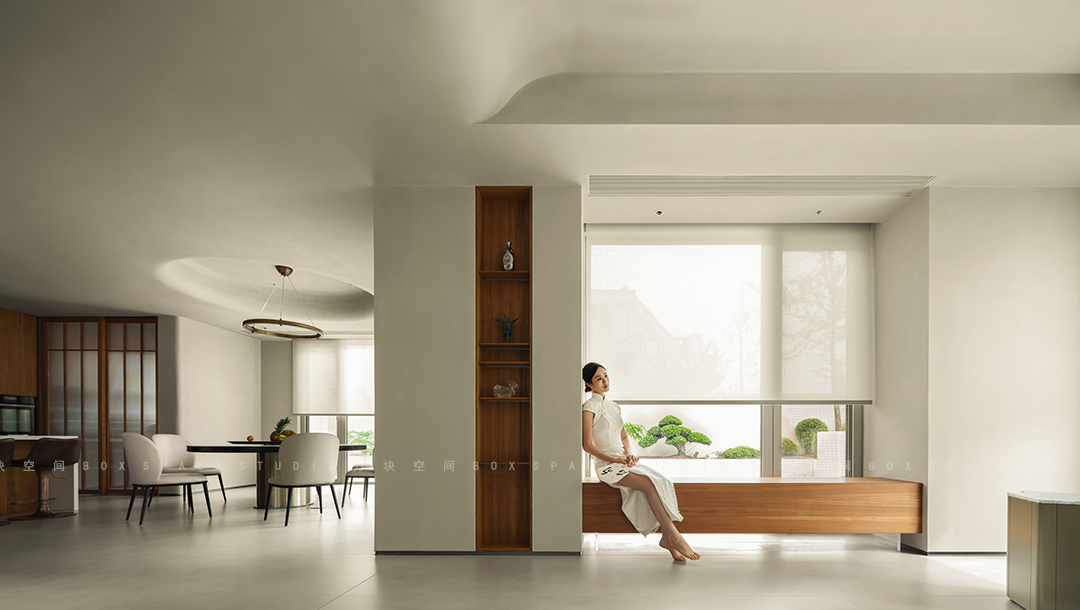Dom
2018-01-23 00:00
© Chao Zhang
张超


架构师提供的文本描述。一个名为“DOM-Ino”的展馆将于2017年在上卫村举办的深圳双年展“城市主义建筑”(UABB)-分展示会上展出。不同于传统建筑,这个展馆没有墙壁,只有24个巨大的铁门。门可以打开或关闭任何角度通过旋转,这允许空间“呼吸”。
Text description provided by the architects. A pavilion called "Dom-Ino" is presented by 2017 Bi-City Shenzhen Biennale of Urbanism\Architecture (UABB) - Sub-exhibition in Shangwei Village. Different from conventional buildings, this pavilion has no walls, but 24 huge iron doors. Doors can be either opened or closed at any angle by rotating, which allows the space to “breathe”.
© Chao Zhang
张超


由勒柯布西耶于1915年提出的“DOM-Ino House”为建筑设计带来了无限的自由规划和立面的可能性。100年后,一座被遗弃在中国南方一个普通村庄的未完工混凝土结构框架的老建筑,与“DOM-Ino House”原型惊人地相似,并像一个样本一样,展示了它在上围村的“多米诺系统”(Domino System)的应用。
"Dom-Ino House" proposed by Le Corbusier in 1915, brings infinite possibilities of free plan and elevation to architectural design. 100 years later, an old building left with unfinished concrete structure frame, found abandoned in an ordinary village of southern China, is strikingly similar to the "Dom-Ino House" prototype, and is demonstrating its application of the "Domino System" in the Shangwei Village, like a specimen.
Courtesy of Benyuan Design and Research Center
本源设计研究中心提供




© Chao Zhang
张超


本源设计研究中心对这座老建筑实施了一系列的改造策略:1。保留原结构的混凝土框架;使用24个巨大的铁门创造一个空间与不同的空间组合,用于艺术和教育的多功能用途。
Benyuan Design and Research center has carried out a series of renovation strategies to this old building: 1. Retain the original structure of the concrete frame; 2. Use 24 giant iron doors to create a space with different spatial combinations for the multi-functional use for art and education.
多姆-伊诺馆成为不同人群和不同文化之间交流的灵活平台。底层有一个工作室,可以用作客户的办公室或公共教育空间。新增加的16个旋转门在二楼,可以封闭和分割空间的各种活动,如艺术展览,社区会议和小型表演等。屋顶露台作为一个社区。
The Dom-Ino Pavilion becomes a flexible platform for communications between different groups of people and different cultures. The ground floor has a studio, which can be used as the client’s office or public educational space. The newly added 16 rotatable doors on the second floor can enclose and split space for various activities, like art exhibitions, community meeting and small performances, etc. And the roof terrace serves as a community social area.
© Chao Zhang
张超




© Chao Zhang
张超


透过任何一扇敞开的门,你都会看到上围村独特的形像:一棵孤独的木瓜树;一处客家老房子的斑驳角落;一座粉红马赛克瓷砖的厂房立面;或村民们建造的欧式房屋。透过巨大的大门,框架的观点揭示了这个村庄的活力和冲突。
Take a glimpse through any open door, you will see a unique image of Shangwei Village: a lonely papaya tree; a mottled corner of old Hakka house; a factory building facade with pink mosaic tiles; or houses of European style built by villagers. Through the giant doors, the framed views reveal the vitality and conflicts of this village.
© Chao Zhang
张超


门上布满了穿孔的图案。白天,阳光穿过小孔,在地上留下阴影。光线和阴影,遵循时间的节奏,以一种有趣的方式对周围的环境作出反应。
The doors are covered by perforated patterns. In the daytime, sunlight goes through the small holes and leaves shadows on the ground. The light and the shadow, following the rhythm of time, respond to the surroundings in an interesting way.
日落后,穿过洞的光线将模糊地形成勒·柯布西耶的脸。通过这个建构了现代西方建筑理论的人的眼睛,人们会看到中国这个南方村庄的生动形象。
After sunset, the light coming through the holes will vaguely form the face of Le Corbusier. Through the eyes of this man, who constructed the modern western architecture theory, people will catch a vivid image of this southern village of China.
Courtesy of Benyuan Design and Research Center
本源设计研究中心提供


























































.jpg)















Architects Benyuan Design and Research Center
Location 99 Shang Wei Lu, Baoan Qu, Shenzhen Shi, Guangdong Sheng, China
Lead Architects Jianmin Meng, Xi Chen, Fanbo Zeng
Design Team Nan Jiang, Jingyi Liang, Jianhua Lei
Area 303.0 m2
Project Year 2017
Photographs Chao Zhang
Category Renovation
Manufacturers Loading...
























